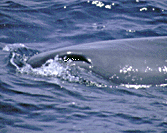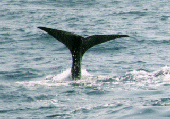Sperm Whale

Scientific Name: Physeter catodon | Current Range: Oceanic
The sperm whale is the largest odontocete, or toothed whale. It has been portrayed frequently in art and literature as a symbol of the great whales, and is best known as the leviathan Moby Dick in Melville's novel by that name. Unique in appearance, the sperm whale seems to have social characteristics that, to date, also appear to be unique among whales. Sperm whales are among the deepest diving cetaceans, and are found in all oceans of the world. Females and their young travel in family units, whereas the much larger males rove between breeding and feeding grounds, as well as among groups of females when breeding.
Male giant sperm whales weigh between 35,000 and 50,000 kg. Females only weigh about 1/3 as much as males. Males may reach 19 m while females are only 12 meters. Newborn calves measure about 4 m and are about 1/25 the weight of females. The enormous (up to 1/3 of total body length), box-like head of Physeter catodon sets it apart from all other species. The head contains a spermaceti organ whose function is not entirely known. It may serve to focus and reflect sound or may be a cooling organ to diminish the whale's volume and its buoyancy during prolonged dives. The giant sperm whale has the largest of mammalian brains, both in proportion to its body and in sheer mass (approximately 9 kg). The blowhole slit is S-shaped and positioned on the left side of the head. There are 18-28 functional teeth on each side of the lower jaws, but the upper teeth are few, weak and nonfunctional. The lower teeth fit into sockets in the upper jaw. The gullet of Physeter catodon is the largest among cetaceans; it is in fact the only gullet large enough to swallow a human.

The dorsal fin is replaced by a hump and by a series of longitudinal ridges on the posterior part of the back, and the pectoral fins are quite small, approximately 200 cm. long. Tail flukes are 400-450 cm. The blubber layer of the giant sperm whale is quite thick, up to 35 cm. With respect to coloration, males often become paler and sometimes piebald with age. Both sexes have white in the genital and anal regions and on the lower jaws.
The main source of food for sperm whales is medium-sized deep water squid, but they also feed on species of fish, skate, octopus, and smaller squid. A sperm whale consumes about one ton (907 kg) of food each day. The lower jaw contains 18-25 large teeth on each side of the jaw, 3-8 inches in length. The upper jaw may have tiny teeth but they rarely erupt. The upper jaw contains a series of sockets into which the lower teeth fit.
Females mature sexually at 8-11 years, and males mature at approximately 10 years, although males do not mate until 25-27 years old because they do not have a high enough social status in a breeding school until that point. Maximum known life span is 77 years. Gestation period is 14-16 months and a single calf is born, which nurses for up to 2 years. The reproductive cycle occurs in females every 2-5 years. The peak of the mating season is in the spring in both Northern and Southern hemispheres so that most calves are born in the fall.

Sperm whales are found in all oceans of the world. Giant sperm whales are very deep divers and may stay submerged from 20 minutes to over an hour. When they surface, sperm whales typically blow 20-70 times before redescending. They produce a visible spout made by the condensation of the moisture combined with a mucous foam from the sinuses. Giant sperm whales typically swim at speeds no faster than 10 km per hour, but when disturbed they can attain speeds of 30 km per hour. Giant sperm whales are highly gregarious, polygamous and group themselves roughly by age and sex in group sizes of 100 or more individuals. Loose family groups of about 30 individuals, however, are more common. Groups are often made up of either bachelor bulls (sexually inactive males) or "nursery schools" of mature females and juveniles of both sexes. Older males are usually solitary except during the breeding season. During the breeding season, breeding schools composed of 1-5 large males and a mixed group of females and males of various ages form. At this point, there is intense competition among the males for females (including physical competition resulting in battle scars all over the heads of males). Only about 10-25% of fully adult males in a population are able to breed.
Sperm whales use clicking noises for echolocation, but they also make a variety of other sounds including "groans, whistles, chirps, pings, squeaks, yelps, and wheezes" (Ellis 1980). Their voices are quite loud and can be heard many kilometers away with underwater listening devices. Each whale also emits a stereotyped, repetitive sequence of 3-40 or more clicks when it meets another whale. This sequence is known as the whale's "coda."
Why are they endangered...
Sperm whales are still fairly numerous, but selective killing of the larger breeding-age males over many years upset the male-to-female ratio, and the birth rate has seriously declined in some populations. The average size of sperm whales killed noticeably decreased during the last 40 years of hunting.





